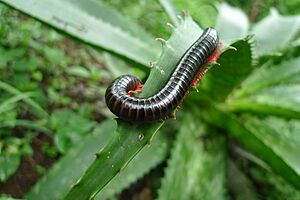Doratogonus facts for kids
Quick facts for kids Doratogonus |
|
|---|---|
 |
|
| Scientific classification | |
| Kingdom: | |
| Phylum: | |
| Class: | |
| Order: |
Spirostreptida
|
| Family: |
Spirostreptidae
|
| Genus: |
Doratogonus
Attems, 1914
|
| Species | |
|
See text |
|
Doratogonus is a group of large millipedes found in Southern Africa. These interesting creatures can grow quite long, from about 8 to 20 centimeters (3 to 8 inches). They are fairly common in their natural homes.
Contents
Meet the Doratogonus Millipedes
Doratogonus millipedes are part of a family called Spirostreptidae. They are known for their long, cylindrical bodies and many legs. These millipedes play an important role in their ecosystems. They help break down dead plant material, which enriches the soil.
Where Do They Live?
You can find Doratogonus millipedes all over Southern Africa. This includes countries like South Africa, Lesotho, Eswatini, Mozambique, Botswana, Namibia, and Zimbabwe. They live in various habitats, from forests to grasslands.
Why Are Some in Danger?
Sadly, many species of Doratogonus millipedes are facing threats. They are listed on the IUCN Red List because their homes are being destroyed. This is often due to human activities like building, farming, or logging. Protecting their habitats is very important to keep these unique creatures safe.
Understanding Conservation Status
The IUCN Red List is like a report card for how endangered different species are. It helps scientists and conservationists know which animals and plants need the most help. Here's what the different statuses mean for Doratogonus millipedes:
- CR: Critically endangered
 means a species is at an extremely high risk of disappearing forever.
means a species is at an extremely high risk of disappearing forever. - EN: Endangered
 means a species is at a very high risk of becoming extinct.
means a species is at a very high risk of becoming extinct. - VU: Vulnerable
 means a species is at a high risk of extinction in the wild.
means a species is at a high risk of extinction in the wild. - LC: Least concern
 means the species is widespread and abundant.
means the species is widespread and abundant. - DD: Data deficient
 means there isn't enough information to properly assess the species' risk.
means there isn't enough information to properly assess the species' risk.
Many Species, Different Risks
There are many different species within the Doratogonus group. Some of them are quite common and are listed as "Least Concern." However, a significant number are "Vulnerable," "Endangered," or even "Critically Endangered." For example, the Doratogonus major is critically endangered. This means it faces a very high risk of extinction.
Other species like the Badplaas black millipede (Doratogonus furculifer) and the ruby-legged black millipede (Doratogonus rubipodus) are endangered. This shows how important it is to protect their natural environments.

